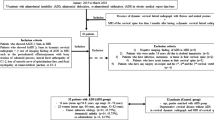Abstract
Three-dimensional spiral CT scanning is now becoming a common investigation in children who have a history of acute torticollis. In the last year, 21 consecutive children who came to our unit with a history of acute torticollis were assessed using standard plain radiographs and a 3-dimensional spiral CT scan. Ten patients had a history of recent trauma. Spiral CT scanning revealed that 13 children had atlanto-axial rotatory subluxation (AARS). Plain radiographs had only a sensitivity of 33% and specificity of 71% in detecting AARS. Sixteen children were treated using a Halter traction. Four failed to resolve clinically and were put on a halo traction after 3-dimensional CT scanning again confirmed residual AARS. Two children remained symptomatic after halo traction, with persisting rotatory and anterior subluxation on repeat spiral CT. They both underwent a posterior in-situ fusion, with no attempt at open reduction. Plain radiography is limited in investigating acute torticollis in children. Spiral 3-dimensional CT reconstruction has an important role to play in both the investigation and management of children who present with acute torticollis.
Resumé
De nos jours l’examen par tomographie informatisée tridimensionelle en spirale devient une technique d’investigation fréquente chez les enfants qui présentent un passé médical de torticolis aigu. Pendant l’année dernière, les cas de vingt-et-un enfants consécutifs qui se sont présentés à notre unité avec un passé de torticolis aigu ont étéévalués à la fois par radiographie simple conventionelle et par tomographie informatiséee tridimensionelle en spirale. Dix patients (50%) avaient dans leur passé un trauma récent. L’examen par tomographie informatisée en spirale a révélé que treize de ces enfants (60%) souffraient d’une luxation partielle rotatoire axiale de la vertèbre atloïdienne. Les radiographies conventionelles n’avaient qu’une sensibilité de 33% et une specificité de 71% pour la détection de cette affection. Seize enfants ont reçu un traitement par traction en bretelle. Quatre enfants parmi ceux-ci (20%) ne sont pas arrivés à la résolution clinique de leur affection, et sont passés à un traitement par traction en auréole, après la confirmation de la persistance d’une luxation partielle résiduelle par la répétition de la tomographie informatisée tridimensionelle. Deux des enfants (10%) ont manifesté des symptômes même après cette deuxième période de traction, la persistance d’une luxation partielle rotatoire et antérieure étant visible au moment d’un nouvel examen par tomographie informatisée en spirale. Les deux ont subi une intervention chirurgicale en vue d’une fusion postérieure en place, sans tentative de réduction chirurgicale de la luxation. Notre conclusion, c’est que la radiographie simple connaît des limitations à l’heure de l’investigation du torticolis aigu chez les enfants. La reconstruction par tomographie informatisée tridimensionelle en spirale a un rôle important à jouer à la fois pour l’investigation et pour le contrôle médical des enfants qui souffrent de torticolis aigu.
Similar content being viewed by others
Author information
Authors and Affiliations
Additional information
Accepted: 30 April 1998
Rights and permissions
About this article
Cite this article
Nicholson, P., Higgins, T., Forgarty, E. et al. Three-dimensional spiral CT scanning in children with acute torticollis. International Orthopaedics SICOT 23, 47–50 (1999). https://doi.org/10.1007/s002640050302
Issue Date:
DOI: https://doi.org/10.1007/s002640050302




